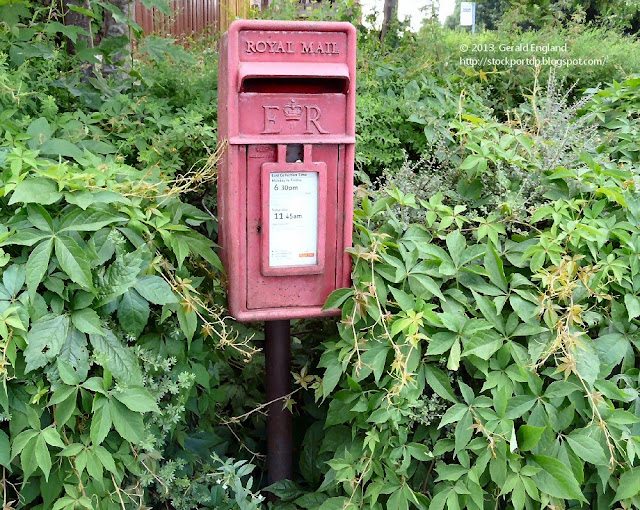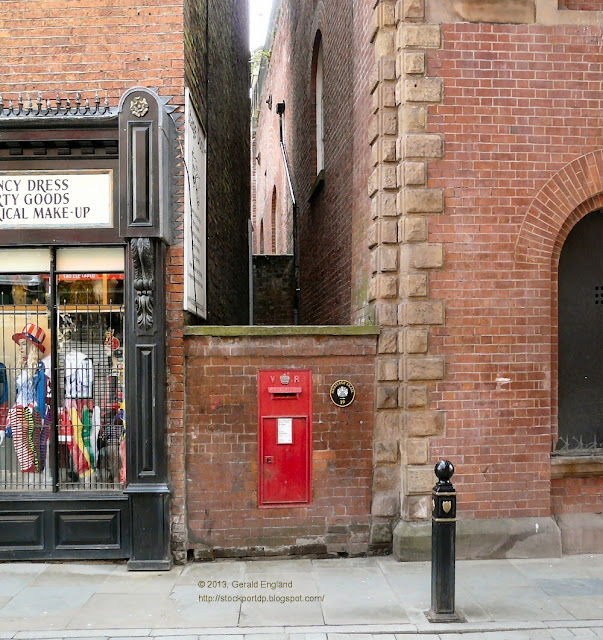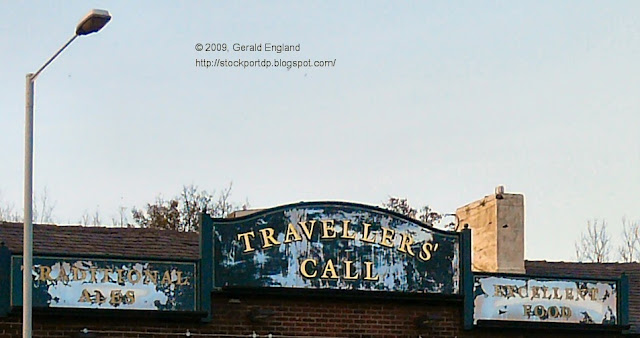Wednesday 31 July 2013
Chestergate from High Bank
A view from High Bank Side looking up Chestergate towards Wellington Road viaduct and the entrance to the bus station and behind that the railway viaduct.
On the right is the former Co-operative store, now Primark. The entrance is from Merseyway Shopping Centre on the other side of the building.
A contribution to ABC Wednesday.
Tuesday 30 July 2013
Elizabethan postbox on Carlton Crescent
Three weeks ago I showed you a Victorian Postbox on Little Underbank.
By way of contrast, this is an Elizabethan postbox on the corner of Carlton Crescent and Newbridge Lane.
A contribution to Ruby Tuesday and Our World Tuesday.
Monday 29 July 2013
St Peter's Chambers
Occupying 35-45 St Petersgate, St Peter's Chambers are grade II listed.
The architect Thomas Allen had offices here in the 1880s and may have been responsible for the design. The plan is rectangular with five shop units on the ground floor, divided into groups of two and a single unit at the south-west end by two doorways with entrance lobbies and staircases to upper-floor chambers. Two chambers with suites of rooms on the first floor.
The south-west end shown here is a slightly projecting range with three first-floor bays and a central gablet in the form of a broken triangular pediment. To the left of the ground floor is a round arched doorway to the first-floor chambers with moulded stone imposts and head with giant keystone rising to a first-floor stone band. Above is a large, central oriel window with a gadrooned stone pedestal base, a semi-circular window with five curved two-pane sash windows separated by slender iron colonettes, surmounted by a decorative ironwork balustrade with sunflower motifs. Above the balustrade, within the gablet, is a round-headed two-pane sash window with moulded stone head and keystone.
A contribution to Whimsical Windows, Delirious Doors.
Sunday 28 July 2013
River Goyt under St Mary's Way Bridge
As the river Goyt passes under St Mary's Way bridge it divides around a grassy island.
This is the view looking downstream from the bridge.
And another from a slightly different angle.
And here's one I took earlier - in March 2009.
A contribution to Sunday Bridges at San Francisco Bay Daily Photo.
Saturday 27 July 2013
St George's Church of England Primary School
A late Gothic-style listed building dating from 1905.
A contribution to The Weekend in Black and White.
Friday 26 July 2013
Coopers Brow
Looking over Coopers Brow from High Street into Lower Hillgate to which it is connected via Coopers Brow which takes a zig-zag dogleg route around the fenced walls.
A contribution to Skywatch Friday and Friday Fences.
Thursday 25 July 2013
Sign of a Quiet Pub
The sign by the doorway to The Railway Inn on Great Portwood Street describes it as a "Quiet Pub" - No Juke Box; No Pool Table.
It is one of three real ale pubs supplied by the Rossendale Brewery.
Before you ask; I don't know what it is like inside; I'm teetotal; I photograph pubs but don't frequent them.
A contribution to signs, signs.
Wednesday 24 July 2013
Bishop Blaize
The sign for the Bishop Blaize on Lower Hillgate Street describes it as a "traditional" pub but in 1852 it was the scene of riots caused by anti-Irish/Catholic feelings. For a time it was renamed "The Gladstone".
A contribution to ABC Wednesday.
Tuesday 23 July 2013
Joseph Mott House
Joseph Mott House at 53 Buxton Road, Heaviley is a listed building.
The late 16th century former house, altered in the 19th and 20th centuries is a remnant of the former Lockwood Fold, a semi-rural hamlet. The 2-storey building is constructed at right-angles to the road, clad in 19th century applied false timber-framing and render, which is said to conceal remnants of a timber-framed structure. The roof is concrete-tiled. The 20th century doorway is on the gable-end, the windows are all late 20th century, and there is a roughly moulded rendered band at first floor level, perhaps suggesting a jetty. Number 53 is the lower addition attached to the south-west corner, similarly clad and with two small late 19th century timber shop fronts and a Welsh slate roof. To the rear is a similar range attached at right angles.
Lockwood Fold was one of a group of folds in north Cheshire and east Lancashire, a locally distinctive group of buildings where farm buildings combined with small workshops for domestic-scale manufacturing, in this case, of hats. Buildings formerly to the north and part of the group have been lost.
At present it is the offices of the firm Computer England.
A contribution to Our World Tuesday.
Monday 22 July 2013
The (Old) Star Inn, Cheadle
The pub sign on the old inn in the centre of Cheadle that serves "Hydes Queens Brewery Ales" says simply "The Star Inn".
Curiously though the design on one of its etched windows declares "Old Star Inn".
A contribution to Whimsical Windows, Delirious Doors.
Sunday 21 July 2013
St Chad's Roman Catholic Church, Cheadle
St. Chad's is part of the Catholic Diocese of Shrewsbury, comprising the adjoining villages of Cheadle and Gatley.
St Chad was Bishop of Lichfield in the 7th century and Cheadle would have been part of his diocese. In 1874 a medieval preaching cross was found near the Parish Church of St. Mary. It is in the distinctive form of the cross of St. Chad, which is also found in the arms of Lichfield Cathedral.
St. Chad's Parish began as a Mass Centre served from Edgeley. Mass was first celebrated in 1900 in a private chapel at Cheadle Old Hall which stood between Cheadle Institute and what is now Queens Gardens. Fr. Abram, the priest at Edgeley, purchased an area of open ground on Stockport Road between Bank Street and Jackson Street. A corrugated iron chapel was constructed on the site as a Chapel of Ease, dedicated to St. Chad. It was blessed on 2nd October 1904 and was served by the priest at Our Lady's Edgeley - first Fr. Abram and then Fr. McGreever.
In 1928 Fr. Peter Lancelot Pears was appointed to Cheadle as the first resident priest. He quickly realised that a new church was needed to house the growing congregation. Bishop Hugh Singleton laid the foundation stone on 24th August 1930, and the church was completed and opened on 15th February 1931. At the same time Fr. Pears built a presbytery beside the church and he lived there until he left the parish in 1938.
Fr. Peter Morgan replaced Fr. Houghton and continued to implement the changes of Vatican II. To encourage the participation of the whole congregation in the liturgy he brought the choir down from the loft into the main body of the church. By the 1980s the old iron church had passed its sell-by date and it was decided to build a new hall in front of the presbytery. This opened in 1984.
In 2007 Bishop Brian grouped the parishes of the Diocese into Local Pastoral Areas, so that parishes could co-operate more effectively with each other and share resources. St. Chad's was linked again with its daughter churches, St. Ann's and Christ Church.
The information here is mostly gathered from the Church website.
A contribution to Inspired Sundays.
Saturday 20 July 2013
Rostron Brow
Looking up Rostron Brow towards St Mary's Church.
The original photograph was cropped, made greyscale and then using the art-media effects in Paintshop Pro turned into a "black pencil sketch" adjusting the parameters until I was happy with the result.
A contribution to The Weekend in Black and White.
Friday 19 July 2013
The Thatched Tavern, Reddish
The roof of the Thatched Tavern in Reddish is slate-tiled just like the terraced houses further along Stanhope Street.
Maybe it wasn't always that way.
A contribution to Skywatch Friday.
Thursday 18 July 2013
Ghost sign on Buxton Road, Heaviley
This ghost sign is on the side of a building on Buxton Road, Heaviley. It seems to have belonged to a "Removals & Storage" firm originally. On the left is a gunshop; on the right is a cemetery.
A contribution to signs, signs.
Wednesday 17 July 2013
Abbey House
Sandwiched between the Prudential Assurance Building (1922) and The Imperial on St Petersgate is Abbey House. It was built on the site of the Theatre Royal which closed in the late 1950s and was demolished in 1962. Originally the Stockport branch of the Abbey National Building Society (before it became a bank), in the noughties it was a nightclub called "sk One" which closed around 2008/9. Some of the upper storeys have been/are being used as offices.
A contribution to ABC Wednesday.
Tuesday 16 July 2013
The Bambooza
Next to the Bulls Head on Market Place is the nightclub, Bambooza. The grade II listed building was erected for the Bank of Stockport to designs of T. A. Allen in 1868. It was taken over by the Manchester County Bank in 1871, which was itself subsequently taken over by the National Westminster Bank.
A contribution to Our World Tuesday.
Saturday 13 July 2013
Friday 12 July 2013
Royal Oak Yard
Named after a pub here called the Royal Oak in 1680. Caves cut into the red sandstone cliffs on the right were once used by tinsmiths. Access to High Street via steps has now been closed.
Today the yard is home to offices and some housing. The Tin Brook flows underneath.
Access is via a cobbled lane under St Petersgate Bridge from Little Underbank.
A contribution to Skywatch Friday.
Thursday 11 July 2013
Mount Crescent and Duke Street
Street name signs on the Magnet public house at the corner of Wellington Road North and Andrew Street.
Neither Mount Crescent nor Duke Street appear now on local street maps.
A contribution to signs, signs.
Wednesday 10 July 2013
Z is for Zuri
The Zuri bar is located on the busy "Rising Sun Junction" where the A6 London Road out of Hazel Grove divides into Buxton Road and Macclesfield Road.
A contribution to ABC Wednesday.
Tuesday 9 July 2013
Victorian Post Box on Little Underbank
Between the Fancy Dress shop on Little Underbank and the St Petersgate Bridge is a Victorian Post Box.
This particular design of wall box was manufactured from 1881 until the end of her reign.
It is still in use and like all UK post boxes shows the times of the last collection which is 6.30 pm Monday to Friday and 11.45 am Saturday. There are no collections on Sunday.
A contribution to Ruby Tuesday and Our World Tuesday.
Monday 8 July 2013
8 Market Place and 1a Mealhouse Brow
A listed building consisting of a late 18th or early 19th century house incorporating a 19th century shop front and reusing timbers of medieval or 17th century origin. The building is approached by a flight of stone steps. A low frontage wall with a cast-iron lamp standard is the parapet of 1a Mealhouse Brow, which is on a lower level owing to the slope of the land. Three storeys to the Market Place, of brick in Flemish bond, with a bracketed eaves cornice and restored sash windows. The windows have repaired stone lintels and original stone sills. A facsimile rainwater head has the date 1743, the original perhaps salvaged from another building or from an earlier building on the site. The shop front is bowed and has terracotta foliated brackets supporting a cornice on each side. The rear wall of the building incorporates timbers with mortices and peg holes.
1a Mealhouse Brow consists of a single-storey range towards the Market Place and the adjacent basement and lower basement of No. 8 Market Place. The upper rooms of this part were used for meetings of the town's manorial court leet, and incorporates two small chambers possibly used as lock-ups, The lower basement incorporates two separate chambers used for confinement until 1790 when a new prison was built.
The second-storey wall has ghost advertising (partially obscured) which relates to its past use as Ladies and Gents Tailors. Currently empty, recently it was occupied by the "Vintage Style Agency" but in 2010 it was a coffee shop.
A contribution to Whimsical Windows, Delirious Doors.
Sunday 7 July 2013
Stockport Baptist Church
Greek Street Baptist Chapel was built in a Romanesque style around 1869 with a capacity to seat 800 people. It was the largest Baptist church in Greater Manchester, and stood in the centre of a busy residential area.
By the 1970s, however, Greek Street Chapel was no longer viable financially, requiring large amounts of maintenance, and was demolished in 1978. It is because of this building that the church is still known as Greek Street Baptist Church by many people in Stockport, even though the present church building is behind Greek Street on Thomson Street.
The present church building was originally the church hall or Sunday school. It was newly refurbished in 2003/4.
Church website: http://www.stockportbaptist.org/.
A contribution to Inspired Sundays.
Saturday 6 July 2013
River Goyt from Park Bridge
The River Goyt as viewed from Park Bridge on Great Portwood Street.
The Goyt rises on the moors of Axe Edge, near the Cat and Fiddle Inn. It runs from the Errwood and Fernilee reservoirs, north of Buxton to Stockport where just around the next bend it joins the River Tame to form the Mersey.
A contribution to Weekend Reflections and Scenic Weekends.
Thursday 4 July 2013
Signs for the Travellers' Call
This is the inn sign for the Travellers' Call at Bredbury.
The J W Lees house stands on what used to be the main road out of Stockport to Yorkshire.
Above the main door, the name is spelt out in a mosaic, complete with an apostrophe in its proper position. This is a fairly recent replacement for the rather well-worn garish signage present in 2009.
A contribution to signs, signs.
Wednesday 3 July 2013
Tuesday 2 July 2013
Monday 1 July 2013
Laura Ashley Facade
The Bridge Street side of the Laura Ashley store in Stockport.
Their store occupies the site of the former Warren Bulkeley Arms on the corner of Warren Street and Bridge Street. The inn was demolished in 1986 but the facade, by James Hunt of Stockport, 1890, was reconstructed on Bridge Street.
Pevsner described it as "Proud terracotta parapet balustrade and cartouches with arms".
A contribution to the July CDPB theme Facade.
Subscribe to:
Posts (Atom)





































